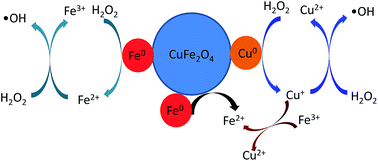Enhanced heterogeneous Fenton-like degradation of methylene blue by reduced CuFe2O4†
Abstract
To facilitate rapid dye removal in oxidation processes, copper ferrite (CuFe2O4) was isothermally reduced in a H2 flow and used as a magnetically separable catalyst for activation of hydrogen peroxide (H2O2). The physicochemical properties of the reduced CuFe2O4 were characterized with several techniques, including transmission electron microscopy, X-ray diffraction, X-ray photoelectron spectroscopy and magnetometry. In the catalytic experiments, reduced CuFe2O4 showed superior catalytic activity compared to raw CuFe2O4 for the removal of methylene blue (MB) due to its relatively high surface area and loading Fe0/Cu0 bimetallic particles. A limited amount of metal ions leached from the reduced CuFe2O4 and these leached ions could act as homogeneous Fenton catalysts in MB degradation. The effects of experimental parameters such as pH, catalyst dosage and H2O2 concentration were investigated. Free radical inhibition experiments and electron spin resonance (ESR) spectroscopy revealed that the main reactive species was hydroxyl radical (˙OH). Moreover, reduced CuFe2O4 could be easily separated by using an external magnet after the reaction and remained good activity after being recycled five times, demonstrating its promising long-term application in the treatment of dye wastewater.

- This article is part of the themed collections: Water treatment and Editors' collection: Environmental chemistry: Pollution control


 Please wait while we load your content...
Please wait while we load your content...